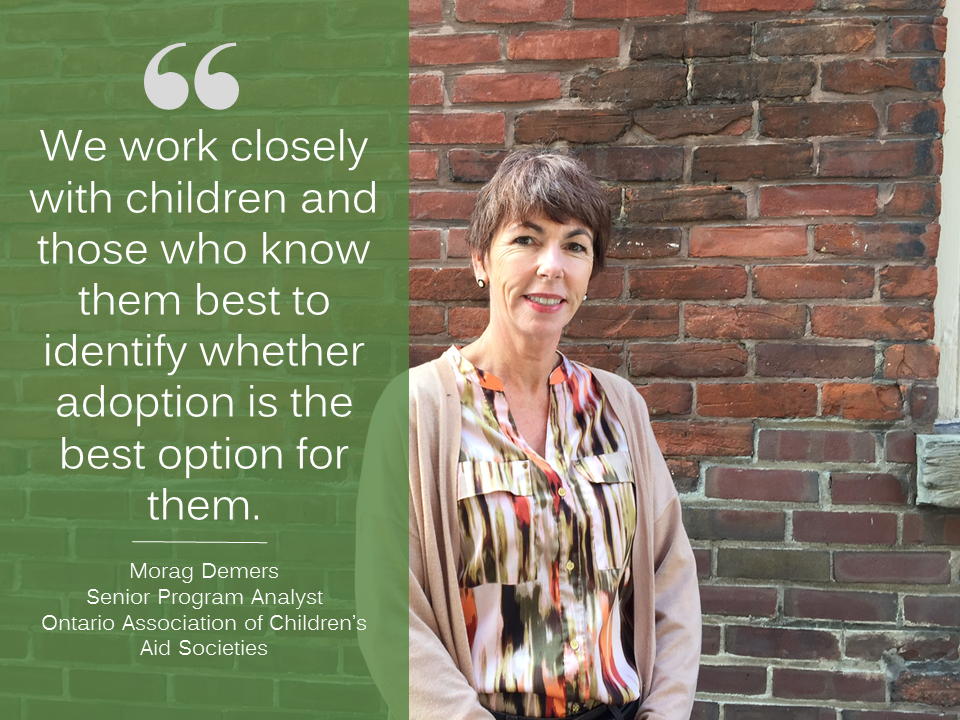Senior Program Analyst Morag Demers talks about what public adoption looks like today.
Many people don’t realize that Children’s Aid is responsible for public adoption in Ontario. Can you clarify the role that Children’s Aid plays in finding forever families for kids?
Under the Child, Youth and Family Services Act it’s our legislative responsibility to find permanent families for children who for a variety of reasons are not able to grow up with their biological families of origin. Our primary goal is to help support children and youth to live safely with their families of origin – 97% of the work we do is supporting kids in their homes. But in a small number of cases it is not safe for children to remain with their families and that’s when we start considering alternative arrangements, including adoption.
What are some of the key services that CASs provide around adoption?
Perhaps most importantly we work closely with children and those who know them best to identify whether adoption is the best option for them. Specific adoption services are not initiated until it becomes clear that returning home is not an option for them and that living with kith or kin is also not an option. Workers start by introducing the word adoption, and what it means using resources like books and stories with the goal of helping kids to become more familiar, open and comfortable to the possibility of living with another family. The concept or even the use of the word adoption is usually unknown to them and so they feel apprehensive. For older children the realization that they are not returning to their family of origin is painful and they often struggle with divided loyalties.
What kind of adoption services do CASs provide to families interested in public adoption?
We facilitate information and support services for families interested in exploring adoption. This includes training that prepares family for the role they are exploring and home studies (click here for more information about PRIDE pre-service training and the SAFE home study). We also offer post-adoption support services such as adoptive parent groups and in some jurisdictions family counselling and/or therapeutic supports for the child. Finally, we provide disclosure services to adult adoptees who want access to their birth family history.
The Ministry of Children, Community and Social Servicess recently launched a review of adoption services in Ontario. What is the purpose of this review and how is Children’s Aid participating?
In 2015 the Minister of Children and Youth Services (MCCSS) announced a number of initiatives to support permanency and adoption services in Ontario. These initiatives include a review of adoption services in Ontario. The review was launched in September and is being conducted by KPMG.
The sector welcomes the review and is working collaboratively with the Ministry to help the review panel understand the current landscape of public adoption and explore the possibilities for greater efficiency and effectiveness across the system. The review panel has consulted with the OACAS on several occasions and is also reaching out to every Children’s Aid Society. Most importantly we want the review panel to understand how embedded adoption is within other permanency options such as kinship care, customary care, and legal custody – that it’s very difficult to understand adoption without looking at the entire suite of permanency options.
How frequently do public adoptions take place?
Last year we legally finalized 870 adoptions. What many people don’t understand is that the number of children available for adoption has decreased in recent years, and that the average Crown Ward who has been in care for more than two years is over 14 years old. Many of our prospective adoptive applicants are seeking children who are five years old or younger. Young children who come into our care are usually adopted by people known to them such as kin, foster families or adoptive families who had previously adopted a sibling.
What are some areas where you think the public adoption system could be improved?
Children’s Aid Societies in Ontario are deeply rooted in the communities they serve. This kind of a service model allows agencies to tailor their work to the local community and is a strength in our system. However, this approach can create confusion when it comes to adoption. This is because families that are interested in adopting don’t just come from the local community, they come from across the province. Our goal is to try and do a better job of helping people across the province to equitably access resources and information about children looking for forever families.
What are some of the major improvements you have seen in public adoption in the last year?
In 2015 the Ministry facilitated a partnership with the Dave Thomas Foundation to support Wendy’s Wonderful Recruiters program in Ontario. This program targets recruitment of families for older children, children with complex needs and sibling groups. Wendy’s Wonderful Recruiters work within our agencies and focus only on finding permanent, loving homes for children who have unique needs. We have seen some wonderful matches between children and families in the last year.
What are you most excited about for public adoption in 2017?
I’m most excited about the work that is going on between public and private/international adoption practitioners. As private and international adoptions have decreased, these practitioners have started to work more closely with Children’s Aid. This is exciting because they have access to potential parents who might not come directly to us. It increases our ability to match children with families.
